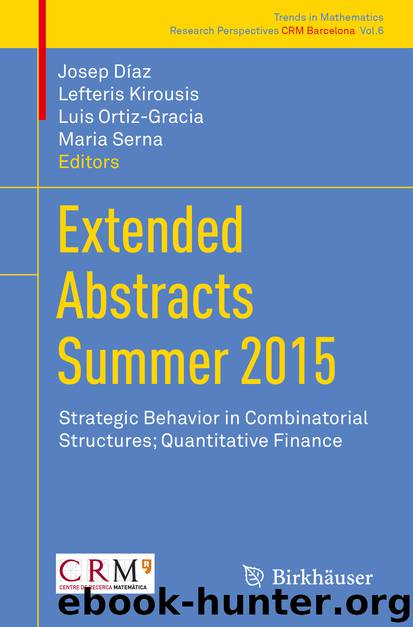Extended Abstracts Summer 2015 by Josep Díaz Lefteris Kirousis Luis Ortiz-Gracia & Maria Serna

Author:Josep Díaz, Lefteris Kirousis, Luis Ortiz-Gracia & Maria Serna
Language: eng
Format: epub
Publisher: Springer International Publishing, Cham
The integer N in the above theorem is referred to as a cut-off point because it marks the onset of subexponential probability for the number of steps (calls of Resample) that M-Algorithm takes before it stops. Clearly, when the algorithm stops we have found an assignment such that none of the events occurs. And since this happens with probability close to 1 for large enough n, Theorem 1 indeed easily follows.
We used our alternative approach to a particular coloring problem, namely the acyclic edge coloring. The entropy compression method had been used in Esperet–Parreau [4] to find bounds for the acyclic chromatic index, the least number of colors needed to properly color the edges of a graph so that no bichromatic cycle exists. Our approach leads to a direct and simple probabilistic analysis giving the upper bound of for the acyclic chromatic index, improving the bound of given by Esperet and Parreau. We also improve their bounds for graphs with bounded girth.
Theorem 3
Assuming , the maximum degree of the graph G, is constant, and given the availability of at least colors, there exists a coloring of the edges such that no two adjacent ones have the same color and no cycle is colored with only two colors. Furthermore, such a coloring can be found by our algorithm (see Fig. 2 ) almost surely.
Fig. 2The coloring algorithm
Download
This site does not store any files on its server. We only index and link to content provided by other sites. Please contact the content providers to delete copyright contents if any and email us, we'll remove relevant links or contents immediately.
The Secrets of Successful Financial Planning by Dan Gallagher(1468)
A Knight's Reward by Catherine Kean(1297)
An American Sickness by Elisabeth Rosenthal(1218)
Against the Gods by Peter L. Bernstein(1072)
America's Bitter Pill: Money, Politics, Backroom Deals, and the Fight to Fix Our Broken Healthcare System by Steven Brill(1042)
FREAKONOMICS by levitt steven d(1036)
SuperFreakonomics by Steven D. Levitt(1031)
America's Bitter Pill by Steven Brill(1013)
Risk Management Framework by James Broad(1000)
Strategic Risk Taking: A Framework for Risk Management by Aswath Damodaran(983)
A Practical Introduction to Security and Risk Management by Bruce Oliver Newsome(980)
2019 Social Security & Medicare Facts by Michael D. Thomas(980)
Game Changers by Rudolf Taschner(945)
How Our Days Became Numbered: Risk and the Rise of the Statistical Individual by Dan Bouk(929)
The New Frontier Investors by Jagdeep Singh Bachher Adam D. Dixon & Ashby H. B. Monk(921)
The 8 Characteristics of the Awesome Adjuster by Carl van Lamsweerde(903)
SUPERFREAKONOMICS by levitt steven d(898)
The Globetrotter's Guide to Travel Insurance: Travel Smarter, Pay Less, Get the Right Coverge (The Savvy Traveler Series Book 1) by Bauche Michael & Bauche Yvonne(886)
The Advisor Playbook: Regain Liberation and Order in your Personal and Professional Life by Duncan MacPherson & Chris Jeppesen(866)
